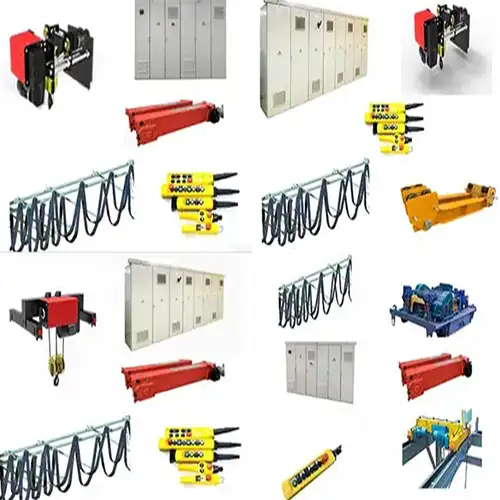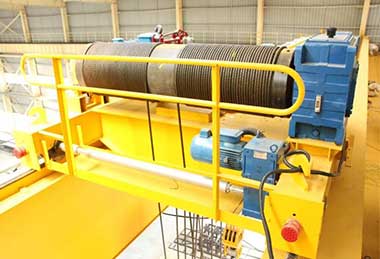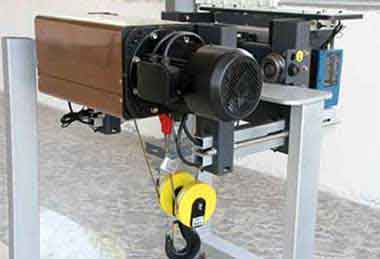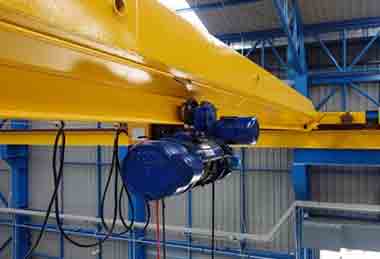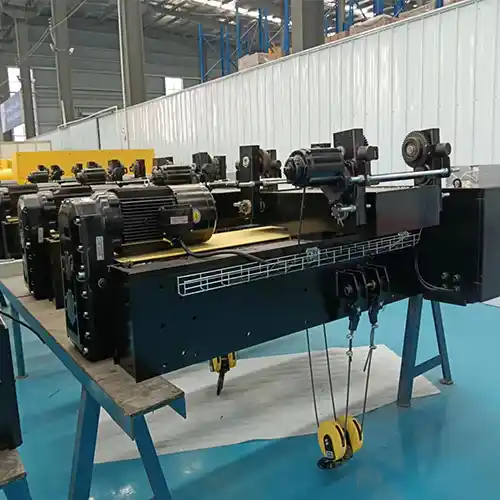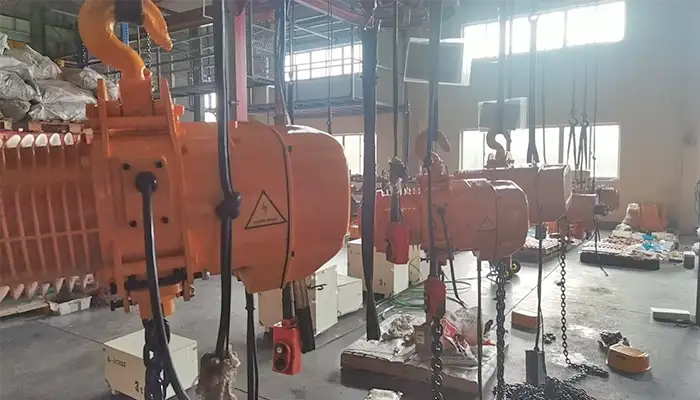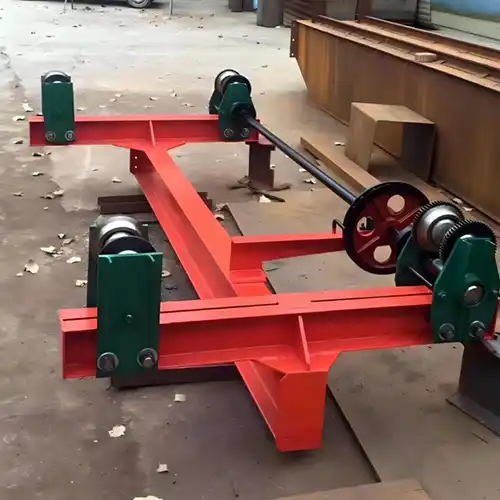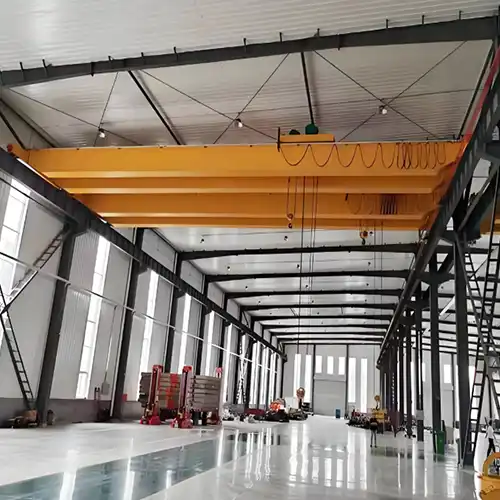Bridge Crane kits, Cheaper Overhead Crane kits & Eot Crane Kits
What's overhead crane kit? A complete overhead crane solution except the supporting steelwork & girder beam, a cheaper crane kit for warehouse & workshop.
Category: Crane Kit Parts
Your Trusted Overhead Crane & Bridge Crane Kit Manufacturer & Supplier
Bridge Crane kits, Cheaper Overhead Crane kits & Eot Crane Kits
What's overhead crane kit? A complete overhead crane solution except the supporting steelwork & girder beam, a cheaper crane kit for warehouse & workshop. Types of eot crane kits are available such as, Single overhead traveling crane kits,Single overhead suspension crane kits & Double overhead traveling crane kits, etc.
Thanks to the large selection of crane kits, finding the ideal bridgecrane for your customers has been simpler.We can help you keep things as straightforward as possible when it comes to making an order and interacting with your clients by grouping together all the necessary parts andcomponents needed to build an overhead crane, with the exception of the beam and gantry steelwork.

overhead crane kit & bridge crane kit, a cost-effective solution except the main girder, why it more economical
A crane kit is a package or set of components that contains the necessary parts to assemble a crane. It is designed for ease of transportation, storage, and installation. Crane kits are commonly used in the construction industry, manufacturing facilities, warehouses, and various other applications where lifting heavy loads is required.
The contents of a crane kit can vary depending on the type and size of the crane being assembled, but typically it includes:
- Structural components: This includes the main frame, beams, and other structural elements that form the crane's framework.
- Hoisting equipment: Components related to the lifting mechanism, such as the hoist, wire ropes or chains, and lifting hooks.
- Trolley system: The components that allow the crane to move horizontally along the beams, usually consisting of a trolley, wheels, and rails.
- End trucks or bogies: The components supporting the bridge girder or main beam and allowing it to move along the crane runway.
- Electrical components: These include the control panel, motors, limit switches, and other electrical components necessary for the crane's operation.
- Fasteners and hardware: Bolts, nuts, washers, and other hardware required for assembling the crane.
The advantage of using crane kits is that they provide a standardized and convenient solution for building cranes, allowing for easier maintenance and replacement of parts. Additionally, crane kits are often more cost-effective compared to purchasing a fully assembled crane, especially when local regulations or space constraints make pre-assembled cranes challenging to transport and install. Crane kits are available in various configurations to suit different lifting capacities and applications.
Types of overhead crane kits
The components included in overhead crane kits can vary based on the type and configuration of the overhead crane. Here are the main types of overhead crane kits and what they typically include:
Single Girder Overhead Crane Kit:
- Single girder bridge components: This includes the main girder (beam) that supports the hoist and trolley.
- End trucks: Components that support the bridge girder and allow it to move along the crane runway.
- Hoist unit: The hoisting mechanism responsible for lifting and lowering the loads.
- Trolley system: Components that allow the hoist to move horizontally along the length of the bridge girder.
- Electrical components: Control panel, motors, limit switches, and other electrical parts required for crane operation.
- Festooning system or conductor bar: Provides power supply to the moving components.
Double Girder Overhead Crane Kit:
- Double girder bridge components: Two main girders that support the hoist and trolley, offering higher load capacity and stability.
- End trucks: Similar to single girder cranes, these support the bridge girder and enable movement along the crane runway.
- Hoist unit: The hoisting mechanism capable of lifting and lowering heavy loads.
- Trolley system: Components that enable the hoist to move horizontally along the length of the bridge girders.
- Electrical components: Control panel, motors, limit switches, and other electrical parts needed for crane operation.
- Festooning system or conductor bar: Provides power supply to the moving components.
- Check 10 ton 10 Ton Overhead Crane Kit, Custom Bridge Crane Kit for Sale for Uzbekistan for Your Reference and Contact us to get your customized overhead crane kit.
- Gantry frame components: The main structure of the crane, consisting of vertical legs and horizontal girders.
- End trucks or bogies: These support the main girder and allow it to move horizontally along the crane's runway.
- Hoist unit: The hoisting mechanism responsible for lifting and lowering loads.
- Trolley system: Components that enable the hoist to move horizontally along the main girder.
- Electrical components: Control panel, motors, limit switches, and other electrical parts required for crane operation.
- Festooning system or conductor bar: Provides power supply to the moving components.
- Check single girder gantry crane kit and double girder gantry crane kit
Jib Crane Kit:
- Jib arm components: The horizontal arm that extends from a vertical column and supports the hoist.
- Pillar or column: The vertical support structure that holds the jib arm in position.
- Hoist unit: The hoisting mechanism responsible for lifting and lowering loads.
- Electrical components: Control panel, motors, limit switches, and other electrical parts needed for crane operation.
It's essential to consider the specific requirements of your lifting tasks and the environment when selecting the appropriate overhead crane kit. Different manufacturers may also offer variations in the kit components to suit individual needs and preferences.
Main Parts and Components in Overhead Crane kits
Our overhead crane kits, sometimes called bridge crane kits, include an electrichoist unit of your choice together with all necessary parts and components such asend carriages, drives, control panels, cabling, fittings, and accessories.
This implies that, with the exception of the supporting steelwork and overhead bridgegirder beam, you willreceive everything you need to assemblea bridge craneor overhead crane of any capacity for any application.
Bridge Frame
- End beam -a rigid connection between the end beam and the main beam.
- Trolley track –to ensure that the trolley runs well, the whole track with joints arewelded together.
- Walkway and railing - The bridge platform's tread is made of 3mm thick steel plate with a non-slip design. The sections of the bridge frame are equipped with railings that have a 1050mm height.
Crane control
Pendent control,Remote control & Cabin Control. The cabin control adopts a closed, toughened glass driver's cab.The driver's cab's framework is made of rolled steel and pressed thin steel plates, and the floor is covered with insulating rubber carpeting. It is safe and convenient to wipe the glass's interior and exterior.

Advantages of the crane controls
- Control systems that are ergonomically optimized
- Safe, fatigue-free craneoperation
- DLC pendant control (suspended by cable for separate travel on the crane girder)
- Remote radio control with an optional handheld transmitter equipped with proportional pushbuttons or joystick transmitter modules.
- All transmitters feature variable frequency radio operation for interference-free transmission and reception
Hoist Trolley/ Built-in Hoist Trolley
Hoisting mechanism - The overhead crane's hoisting mechanism is made up of a driving device, a steel wire rope winding system, a fetching device, and a safety protection device.
Trolley running mechanism –It is responsible for driving the hoisting trolley. The speed of the electric overhead travelling crane is frequently increased to improve its working efficiency.
Advantages of the hoist and hoist trolley
- High handling rates, high efficiency
- Small approach dimensions,Compact design
- Large hook path
- Optimal use of building space and height
- Low-sway transportation and gentle placement are made possible because of the variabletravel and lifting speeds.
- Safe, reliable, and convenient craneoperation
Bridge Travelling Mechanism

Crane travelling unite- end carriages
The overhead bridge crane is driven by two independent driving systems.
The diameter and material of the bridge running mechanism are chosen based on the maximum supporting force that the wheel can bear under the most adverse situations, to prevent overloading of the wheels.
Advantages of travel units and end carriages
- High stiffness
- Torsionally strong, enclosed box-section profile (reinforced connection, welded diaphragm plate)
- Engineering tolerances in the crane girder connection region
- Optimal travel characteristics due to perfect travel wheel axle arrangement and careful adjustment of crane span dimension
- Low wear and maintenance-free travel drives thanks to life-lubricated anti-friction bearings and travel wheels made of spheroidal-graphite cast iron
Power supply
- The standard power supply of our double girderelectric overhead cranesis three-phase AC, 380Vand 50Hz. It can also be tailored to the needs of the user.
- Power feed for the eotcrane: (1)safety cable (2) flexible cable
- Trolley power supply: cable trolley
- The slides used for the feeding of flexible cables and cable trolleys can be steel rope slides, I-steel slides, and special-shaped steel slides.

Check the 4 main types of power supply lines.
Advantages of power supply
- Power source that is dependable and has a long service life.
- Reduces unplanned downtime.
- Pre-assembled sub-assemblies
- Simple to assemble.
- Replace the existing collector trolley or complete straight sections.
- Maximum convenience in maintenance.
- High resistance to accidental contact with the sealing lip, as well as incorporated expansion compensation (IP 23, IP 24).
- Maximum security.
- Trolleys are powered by a pre-assembled trailing cable system.
- Optional energy chain power source for radio-controlled cranes.
Features of overhead crane kit components tailored to meet your needs
Our overhead crane kits provide the maximumquality, effectiveness, and dependability. They are built byusing standardized parts that can be configured for a wide range of application scenarios. All of our eot cranecomponent packages are designed and processedwith ourdecades of expertise. Our eot crane kit has the following features:
- Complete component packages arecustomized to individual requirements for single girderand double girder electricoverhead travellingcranes and suspension cranes.
- Component packages for single and double crab operation.
- Hoist cranes designed to meet application requirements, including electric wirerope and electricchain hoists.
- Optimum combination options
- A simple assembly based on the plug-and-play approach
- High levels of safety, reliability, and efficiency
Benefits of a crane kit
Crane kits are frequently employed by our trade customers who are capable of fabricating a crane girder beam themselves because they receive everything else they want in a single package. Our clients simplify the order process by having the crane kit delivered directly to the assembly site, saving them time and money.
- Because of the lack of the massive girder beam, shipment of our crane kits is cost-effective, especially when transported over long distances or overseas.
- Plug-and-Play connections for convenient assembly
- If you intend to manufacture a girder locally to avoid the high shipping costs associated with delivery outside of your geographic area, our crane kits are very good andcost-effective solutionbecause they can be adapted to the girder of your choice.
- As indicated above, our crane kit component packages for crane installations can be adjusted to the needs of your single girder crane, double girder crane , or overheadsuspension cranes.
Crane kits for repairs
Another popular application for crane kits is to help with repairs. Bridge crane kits can help whether you're maintaining your own crane or providing breakdown service for a client by providing replacements or spares for outdated or worn parts.
The girder and steelwork are more sturdy and long-lasting than the more intricate crane pieces included in our kits, so we can give everything you need to keep your crane functioning well in one single order.
Whether you're an end user or a trade client, our crane kits include standard components as well as all installation manuals and fixings needed to help you reach your aims. If necessary, we can also design the beam or steelwork and ship it separately to the work site.
Crane kit with no girder
The option where the main girder is not provided by the crane manufacturer, and the buyer produces it locally based on the drawings provided, can offer several benefits and considerations:
Benefits of the Solution Without Main Girder:
- Cost Savings: The main girder is a significant and often expensive component of the crane. By producing it locally, the buyer can potentially save on the overall cost of the crane kit.
- Local Sourcing: Producing the main girder locally allows the buyer to source materials and labor from nearby suppliers, reducing transportation costs and supporting the local economy.
- Customization: The buyer can tailor the main girder to suit their specific requirements, such as adjusting the length, height, or load capacity based on the intended application.
- Adaptability: Local production provides flexibility to make modifications or improvements during the fabrication process, allowing the buyer to address any unique site conditions or special requirements.
- Quality Control: By manufacturing the main girder in-house or with a local fabricator, the buyer can have more direct oversight over the quality of materials and workmanship.
Considerations for Buyers Producing the Main Girder Locally:
- Engineering Expertise: The buyer or the local fabricator must have the necessary engineering expertise to understand and interpret the provided drawings accurately. Proper design and structural calculations are crucial to ensure the main girder's safety and functionality.
- Compliance with Standards: The main girder must comply with applicable industry standards and regulations to ensure safe crane operation. This includes factors such as material specifications, welding standards, and load capacity calculations.
- Material Selection: Selecting the right materials for the main girder, such as steel profiles, is essential to meet the required load-bearing capacity and ensure durability.
- Fabrication Facilities: The local fabricator should have adequate facilities and equipment to produce the main girder with precision and quality.
- Quality Assurance: Implementing a robust quality assurance and inspection process is necessary to ensure the final product meets the required standards and specifications.
- Safety and Liability: The buyer should consider potential liability issues related to the crane's safety and performance when producing the main girder locally. Consulting with experts and adhering to best practices can help mitigate risks.
- Timelines: Local production may take additional time compared to receiving a pre-fabricated main girder from the manufacturer. The buyer should factor in the fabrication time when planning their crane project.
In summary, producing the main girder locally can be a cost-effective solution, but it requires careful consideration of engineering expertise, compliance with standards, and quality control to ensure a safe and reliable overhead crane. Engaging with experienced professionals and reputable local fabricators is crucial to the success of this approach.
Technical details on manufacturing main girder and other kits seperately
Producing the main girder and other crane kit components separately requires careful attention to various technical details to ensure the safety, performance, and functionality of the crane. Here are some of the key technical considerations:
Structural Design:
- Load Capacity: Calculate the maximum lifting capacity of the crane based on the application's requirements. The main girder and other components must be designed to handle this load safely.
- Span Length: Determine the distance between the end trucks (for overhead cranes) or the distance between the legs (for gantry cranes). The main girder should be sized accordingly.
- Deflection and Stiffness: Evaluate the deflection and stiffness of the main girder under the maximum load to ensure it meets acceptable limits and provides stable operation.
Material Selection:
- Choose appropriate materials for the main girder and other structural components to achieve the required strength, durability, and corrosion resistance.
- Consider factors such as the crane's operating environment, temperature, and exposure to chemicals or weather.
Welding and Fabrication:
- Ensure the welding procedures and techniques meet industry standards and codes to achieve strong and reliable welds.
- Adequate fabrication facilities and equipment should be available to handle the fabrication process.
Safety and Compliance:
- Adhere to relevant safety standards and regulations for overhead cranes or gantry cranes in the specific application's location.
- Implement safety features such as limit switches, emergency stop systems, and overload protection devices.
Electrical Components:
- Properly size and select electrical components, including motors, control panels, and festooning systems (for overhead cranes), to handle the load and operating conditions.
- Ensure electrical components meet safety and regulatory standards.
Load Testing:
- Conduct load tests to verify that the main girder and other crane kit components can handle the specified load capacity safely.
- Perform functional tests to ensure smooth and proper operation of the crane.
Quality Control:
- Implement a quality control process throughout the fabrication and assembly stages to ensure each component meets design specifications and standards.
- < Inspect critical welds, dimensions, and alignments.
Integration:
- Ensure compatibility and proper fit of the main girder with other crane kit components during assembly.
Documentation:
- Maintain comprehensive documentation of the fabrication process, material certifications, test reports, and compliance with standards.
Professional Expertise:
- Engage qualified engineers and experienced fabricators with expertise in crane design and manufacturing.
By paying attention to these technical details, the produced main girder and other crane kit components should meet the required standards for safety, performance, and functionality. Collaboration with engineering experts and adherence to industry best practices will contribute to a successful crane project.
How to ensure the compartibility of main girder and other crane kit ?
Ensuring the compatibility of the main girder and other crane kit components is crucial to the successful assembly and safe operation of the crane. Here are some steps to achieve compatibility:
- Obtain Detailed Drawings and Specifications: Request detailed drawings and specifications from the crane manufacturer for both the main girder and the other crane kit components. These drawings should include accurate measurements, material specifications, and assembly instructions.
- Review Design and Engineering Standards: Verify that the main girder and other components are designed according to recognized engineering and safety standards for overhead cranes or gantry cranes. Ensure that all parts are suitable for the intended load capacity and application.
- Cross-Check Dimensions: Compare the dimensions and measurements of the main girder with the dimensions of other components in the crane kit. Check that the connecting points and interfaces match and align properly.
- Check Fastening and Connection Points: Ensure that the connecting points for the main girder and other components are compatible and align as per the drawings. Confirm that the fasteners (bolts, nuts, etc.) are of the appropriate size and grade for the intended loads.
- Verify Load Ratings: Confirm that the load capacity and working load limits of the main girder and other crane kit components are compatible and can work together to lift and move loads safely.
- Consult with the Manufacturer: If any doubts or uncertainties arise during the compatibility assessment, consult with the crane manufacturer. They can provide clarifications, guidance, or even customized solutions to address specific requirements.
- Perform Dry-Fit Assembly: Before finalizing the production of the main girder and other components, consider doing a dry-fit assembly. Temporarily assemble the crane kit components without permanent fastening to verify that they fit together properly and align correctly.
- Conduct Load Tests: Once the main girder and other components are assembled, perform load tests to validate the crane's lifting capacity, stability, and overall performance. These tests will help ensure that all components work harmoniously together under operational conditions.
- Follow Assembly Guidelines: Follow the manufacturer's guidelines and instructions for assembling the crane. Pay attention to the sequence of assembly, torque specifications, and any specific requirements provided in the documentation.
- Quality Assurance: Implement a robust quality assurance process throughout the manufacturing and assembly stages to identify and address any potential issues early on.
By carefully considering these steps and ensuring proper communication with the crane manufacturer, you can significantly increase the likelihood of achieving compatibility between the main girder and other crane kit components, leading to a safe and reliable overhead crane or gantry crane.
How to ensure crane end carriages wheels and crane rail ? if the crane rail is also bought locally ?
Ensuring the compatibility of crane end carriages' wheels and the crane rail is essential for smooth and safe crane operation. When purchasing the crane rail locally, follow these steps to ensure compatibility:
- Rail Type and Size: Determine the specific type and size of crane rail required for your overhead crane system. Different crane systems may use different rail profiles (e.g., QU, CR, or TR series) and sizes (e.g., 50 kg/m, 60 kg/m, etc.). Ensure that the rail you purchase matches the specifications provided by the crane manufacturer.
- Consult with Crane Manufacturer: Before buying the crane rail, consult with the crane manufacturer or a qualified engineer to get their recommendation on the appropriate rail type and size based on your crane's design and load requirements.
- Rail Quality: Ensure that the crane rail you purchase meets the necessary quality standards, including material composition, hardness, and straightness. High-quality crane rail is crucial for the smooth movement of the crane end carriages.
- Wheel Profile and Diameter: Verify the wheel profile and diameter required for the crane end carriages. Crane end carriages typically use flanged wheels that run along the crane rail's top surface. The wheel diameter should be compatible with the crane rail size.
- Wheel Material: Select wheels made from materials suitable for the specific application, taking into account factors like load capacity, operating environment, and expected wear and tear. Common wheel materials include forged steel, cast steel, and polyurethane.
- Wheel Load Capacity: Confirm that the load capacity of the crane end carriage wheels matches or exceeds the intended maximum load capacity of the crane.
- Wheel-Groove Clearance: Ensure that there is an adequate clearance between the crane end carriage wheels and the crane rail groove. Proper clearance prevents friction and wear while allowing smooth movement.
- Installation and Alignment: Properly install and align the crane rail to ensure it is level, straight, and securely fastened. Proper alignment is crucial for smooth and stable movement of the crane end carriages.
- Lubrication: Implement a regular lubrication schedule for the wheels and crane rail to reduce friction and wear, ensuring smooth and efficient crane operation.
- Regular Inspection: Regularly inspect the crane end carriages' wheels and the crane rail for signs of wear, damage, or misalignment. Promptly address any issues to maintain safe and reliable crane operation.
By following these steps and collaborating closely with the crane manufacturer and qualified engineers, you can ensure that the crane end carriages' wheels and the locally purchased crane rail are compatible, enabling efficient and safe overhead crane operation.
How to construct the runway for your overhead crane kit ?
Constructing a proper runway for an overhead crane kit is crucial for the safe and efficient operation of the crane. Here are the general steps to construct the runway:
Site Survey and Planning:
- Conduct a site survey to determine the exact location and layout of the crane runway.
- < Identify any potential obstructions, uneven surfaces, or other site-specific challenges that may impact the runway construction.
Obtain Necessary Permits and Approvals:
- Check local regulations and obtain any required permits or approvals for constructing the crane runway.
Foundation and Supports:
- Prepare the foundation for the runway support columns or beams. The foundation should be firm, stable, and capable of supporting the crane's load.
- If needed, install support beams or columns at specified intervals to support the crane runway.
Crane Rail Installation:
- Lay the crane rail along the length of the runway, securing it to the support beams or columns with appropriate fasteners.
- Ensure that the crane rail is straight, level, and properly aligned for smooth movement of the crane.
Alignment and Leveling:
- Use laser levels or other accurate measuring tools to align and level the crane rail along the entire length of the runway. Proper alignment is essential for the safe and efficient operation of the crane.
Welding and Bolting:
- If using jointed sections of crane rail, ensure that the joints are securely welded or bolted together. Properly executed welds or bolts are critical for the structural integrity of the runway.
Reinforcement:
- If required by the crane manufacturer or local regulations, provide additional reinforcement to the runway structure to handle the crane's dynamic loads.
End Stops and Bumpers:
- Install end stops at the ends of the runway to prevent the crane from traveling beyond its intended path.
- Place bumpers or shock absorbers at the end stops to reduce the impact force if the crane accidentally reaches the end of the runway.
Safety Markings and Signage:
- Mark the runway and its safe working load capacity with appropriate safety signs and markings.
- Clearly display any warnings or safety instructions for crane operators and personnel working in the area.
Load Testing and Inspection:
- After the construction is complete, perform load testing to verify the runway's structural integrity and load-carrying capacity.
- Regularly inspect the runway and its support structure for signs of wear, damage, or misalignment, and address any issues promptly.
It's essential to follow the manufacturer's guidelines and local regulations during the construction process. Additionally, consulting with experienced engineers or crane installation experts can help ensure that the runway is constructed to the required standards for safe and reliable overhead crane operation.
FAQ of overhead crane kit
What exactly is included in a crane kit? End trucks, electrification, controls, and a hoist are all part of a bridge crane except the main girder and crane supporting columns. Most plug-and-play kits include most of this, while some manufacturers will also providethe bridge beam as your requirement.
Crane controls can include an attached pendant control or a remote-control device, or cabin control, which is depending on your selection. It's critical to understand what comes with the kit and what you'll need to supply to get your crane up and operating.
What does "Plug-and-Play" refer to? Bridge cranes are typically "hard wired." They need to be wired with three-phase electricity by an electrician. Unfortunately, the DIYer faces numerous risks in this situation. Any electrical connections must be terminated at the precise spotindicated by a wiring schematic in order to avoid serious damage to the equipment during functional testing. A plug-and-play crane kit, on the other hand, is pre-engineered to allow electrical connections to be made using a number of pre-wired plugs and receptacles. These mating crane parts andcomponents are marked with matches for a secure and quick connection.
How should a crane kit be assembled ? Manufacturers of crane kits provide comprehensive manuals and instructions to assist you in assembling your crane kit. Preparing the beam, squaring the end carriages and endtrucks, mounting the trolley hoist, and final electrical plug/receptacle connection are common procedures.
What type ofhoistcomes in a crane kit? A crane kit may include virtually any type ofelectric trolley hoist or manual trolley hoist, whether they are powered by chain or wire rope. The kit will be pre-engineered and customized by the manufacturer for your application.
Who should use a kit to build their own crane? When should you not use a kit crane?
A crane kit's ideal customer is a steel fabricator or contractor with mechanical skill and certified welding capacity. This customer must be able to read a blueprint and wiring connector diagram, as well as understand what is included in their purchase. They're also willing to put in the effort to properly construct the pre-engineered kit so that their overhead crane functions smoothly and safely.
Customers with more complicated requirements should purchase a hard-wired crane and hire a professional installer. This covers wider spans, particular environmental circumstances, a dangerous situation, or other unusual criteria. A special system or equipment configuration may be necessary in special lifting circumstances.
There are crane kits and specialized bridge crane options available.
For inquiries concerning cost-effective DIY overhead cranes by adopting crane kits, please feel free to contact us.
Main Projects
Related Products

Latest project
32/5 Ton Overhead Crane Sale in India: Case Study
Free consultation to Confirm Parameters & Specifications and Get
Latest Crane Price & Crane Rate.
- Types of overhead cranes : _______?
- Optional: Overhead travelling crane, goliath gantry crane,Slewing jib crane, Single girder or double girder crane,small portable crane or kbk crane, etc.
- Capacity of overhead crane: _______?
- Optional: 0.25ton, 0.5 ton, 1 ton, 2 ton, 3ton, 5 ton, 10 ton,15ton, 20ton, 25 ton, 30ton,35ton, up to 550ton, etc.
- Crane span & lifting height : _______?
- Crane travelling length : _____?
- Control of overhead crane:_______?
- Optional: pendant/ remote/cabin control
- Voltage supply of overhead crane:_____?
- Eg,: 380V50/60HZ,3Phase or others,etc.
- Application/usage of crane:_______?
- Eg,: Steel mill, ,injection mold, cement,stone, concrete,granite, general manufacturing, etc.
Just leave a message via the contact form and our hoist and crane engineer will contact you with in 24working hours.
Get In Touch
